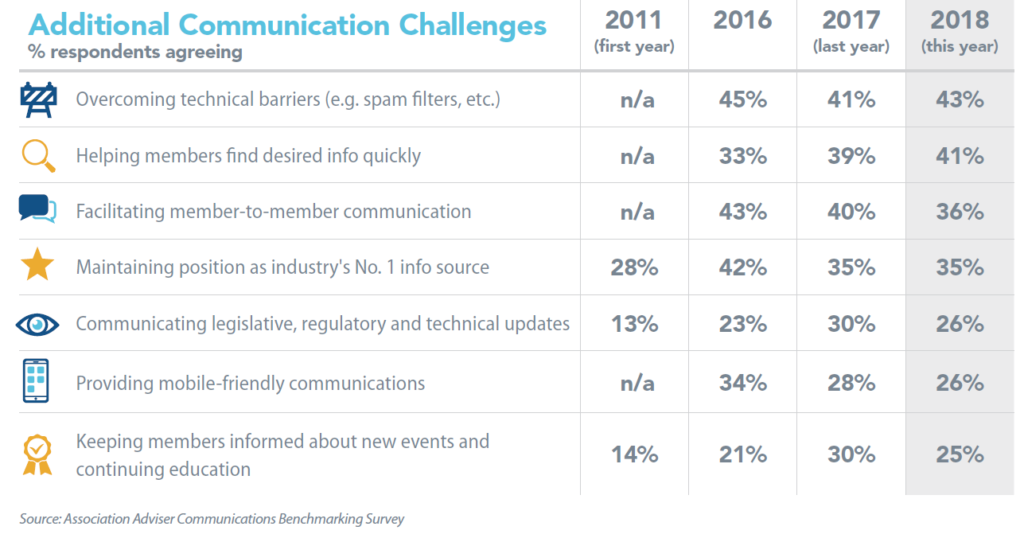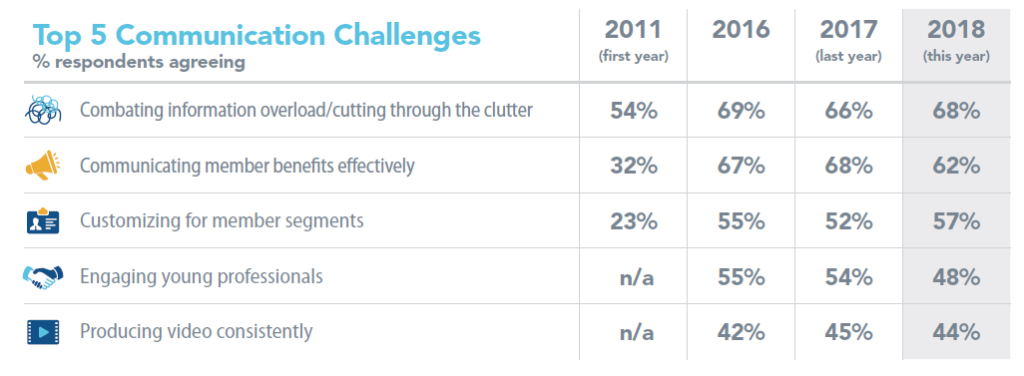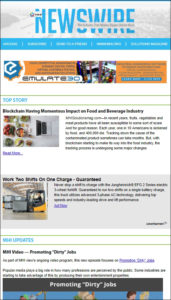The ‘Duck, Duck, Goose’ Aspect of Association Communications
Sometimes, figuring out if your association messages are getting through to your members feels like playing “Duck, Duck, Goose.” You hold your breath in anticipation, hoping they’ll land on “goose” and choose your message as the one of the lucky ones they’ll read that day.
But, what if they do? What if they choose to open your email or read that article; is it going to engage them and encourage interaction? Is it relevant? And, are you prepared to follow up with action items – before they navigate the circle and sit down somewhere else?
These are just some of the questions that plague association leaders and communications experts when figuring out how to best interact with members – and encourage members to respond in kind. It is a top challenge for a lot of associations, No. 1 in 2018, to be exact, according to the 2018 Association Communications Benchmarking Report. “Information overload/communication clutter” resurfaced as the top communication challenge faced by associations in 2018, after temporarily being eclipsed by “inability to communicate member benefits effectively” in 2017.
The first step in communication is research – figuring out what type of information your members are interested in. The second step is making sure they know your messages are addressing their professional interests. Knowing your members is vital to not only reducing their information overload, but will streamline your communication clutter at the same time. Here are some ideas to help you get to know your members and get their attention – and help your communications strategies become more streamlined and effective.
Stop, Scan, Read!
Sometimes, getting your members’ attention – and encouraging them to stop and look – may be as easy as changing the subject line. Show your readers that the content in the email is relevant. Think of the subject line as the headline to the article – and don’t be afraid to make it creative! Or, include some interesting snippets of information in the subject line, so readers are more inclined to open it to find out more. Think of it the same way you would as headline writing for articles. The headline is like a “taste” of what’s inside; and if the headline isn’t attention-grabbing, then there’s a good chance the actual article will put them to sleep!
Snazzy Subject Lines
In 2018, MHI started to adjust the subject lines in their weekly Newswire enewsletter so that the subject lines were more descriptive and reflected some of the article topics in the email. Its effect? Significant. A comparison of a “before” newsletter and “current” one shows that total opens nearly doubled, which equates to thousands more opening the enewsletter every week.
“This improvement tells us there are MHI members and their customers out there paying attention!” said Kelly Clark, manager for online marketing at Naylor.
Avoiding the Spam Folders
Not only is it important to get noticed, but it is equally important to ensure your communications avoid the dreaded spam folder. In our Benchmarking Survey, 43 percent agree that overcoming technical barriers (e.g. spam filters, etc.) is a communication challenge. Supplying relevant, meaningful content is all for naught if the messages never make it to your members’ inboxes!

For example, at the ACI-NA Conference, the communications team and Naylor support staff were struggling to figure out why the daily show enewsletters, Centerlines LIVE, were ending up in the Spam folder for the ACI staff. It ends up, there was a symbol in the subject line that their server flagged – in this case a “/” symbol, which is also an escape character in coding and could be seen as malicious coding. The solution: Do not include symbols in the subject line!
Also, ask members to check their “safe sender” list. First, find out the domain for the email sender, e.g. if you partner with Naylor for this, it is naylorconnect.com. Then, make sure your members add this domain address to their safe sender list, address book or contact list and have them unblock the domain in their firewall program.
Socially Superb
Listening in on social media channels is a great way to gauge how well you are communicating with your members, as well. In fact, in the Benchmarking Survey, one in three respondents strongly agree that social media is a high priority. Hashtags and online group forums have made it easier to connect to members and hear about what is going on in the industry that might be relevant and important to your members. Be sure to monitor your social media channels once you have established them, though, so your members’ comments/questions do not go unanswered. That is a quick way to completely lose their trust.
From Zero to 16,000 Followers
Monitoring various social media channels is a good way to “listen” to your members and others in the industry. You can take monitoring a step further and build a social media presence that becomes a hub for thousands in the industry. That is exactly what Jeanie Clapp, senior content strategist at Naylor, did for the construction industry. As editor-in-chief for Constructor Magazine, she wanted to expand the online communications for AGC of America members. And, since launching @ConstructorMag in 2012 on Twitter, the number of followers has exploded – reaching more than 16,000 in just six years.
 “Twitter is a great way to interact with industry professionals and especially association members,” she said. “I often ask my audience – through Twitter posts – to submit story ideas or contact me if they wish to be considered a source for future stories. In several instances, this has proved to be very successful and resulted in great contributions from AGC member firms.
“Twitter is a great way to interact with industry professionals and especially association members,” she said. “I often ask my audience – through Twitter posts – to submit story ideas or contact me if they wish to be considered a source for future stories. In several instances, this has proved to be very successful and resulted in great contributions from AGC member firms.
“Twitter is a wonderful playground for the association world and the construction industry, a place where information is shared, problems are solved, networking occurs and new friends meet. You’ve probably heard it before, but I’ll reiterate it: To be successful on Twitter, post regularly. That doesn’t mean every hour or every day, but select a schedule and stick to it. You’ll see a steady increase in your Twitter followers and enhanced engagement with your audience. Take it from @ConstructorMag and follow us as we make our way to 20K!”
Conquering Analytics – In Minutes
In the Benchmarking Survey, two out of three respondents said members are too busy to engage with their content. So, finding out what is important to them and getting straight to the point is key, which is where analytics and surveys can help – if you know how to read them and take a few minutes here and there to do so.
The wonders of technology can be hard to keep up with, even for those of us who spend every day in front of a computer. There is so much data that it is daunting to even think of trying to sort through it to find possible trends and solutions. Luckily, the sorting process for many Naylor-published communication options has experienced some, and it is now quite simple to glance through the results and, potentially, pick up on key bits of information that could be invaluable when figuring out how to engage your members.
For example, it took mere seconds to find out the top read article in NAFA’s FLEETSolutions magazine in the past month was “Fleet Policies: Help Has Arrived – Part Three of a Series” followed by “How to Be a Virtual Fleet Manager.” Interestingly, the most-read article was a digital-exclusive article, which supports the idea that offering digital-only articles may be a good way to increase traffic to your online magazine and encourage more online interaction. Keep in mind, too, that it is not just the people on your mailing list that will be drawn to these digital-only articles. By using words such as “exclusive” or “scoop” when referencing the online material, you are inviting readers into an intimate circle comprised of people who share the same interests and are proactively pursuing to increase their knowledge.
Or, dial it down to a specific issue’s article popularity. For example, the Q1 issue of MHI Solutions shows that “Productivity Increases When Robots Work Alongside People” had the most views followed by “Technology Payoffs,” but the latter had an average reader time of almost double the first, more widely-viewed article. Clearly, there is more than one way to measure the popularity of your content.
You can also easily track content performance from issue to issue. For example, the January/February issue of FLEETSolutions had more than twice the number of unique readers as the previous issue. To better understand the popularity of different types of content, there are also sorting options for: Number of Sessions, Average Session per Reader, Average Session Duration and Replica Page Views. Other filtering options include: Performance Summary, Readers by Region, Readers by Operating System (Windows, Mac OS X, Android, iOS, Linux), Readers by Platform (app vs. web), Readers by Device Type (e.g. phone, tablet, desktop).
Similar reports can be run for e-newsletters, websites, online buyers’ guides, directories and show guides. Those reports show where the most online activity is taking place, and can be invaluable in helping with decision-making when it comes to being a valuable resource to your members. What’s relevant to your readers has never been easier to identify, if you know where to look.
Using Analytics to Support Decisions
 In FLEETSolutions, the official magazine for NAFA Fleet Management Association, the January/Feb issue had an article on “NYPD’s Emergency Service Unit” that had the most number of unique visitors, followed closely by the article, “5 Tips for Right-Sizing Your Fleet.” In November/December, the average Duration/Reader time for the “How This NAFA Member Runs One of the World’s Largest Fleets” was significantly higher than the rest of the articles. NAFA used this information, in part, to help determine which types of articles they wanted to include in their annual editorial plan.
In FLEETSolutions, the official magazine for NAFA Fleet Management Association, the January/Feb issue had an article on “NYPD’s Emergency Service Unit” that had the most number of unique visitors, followed closely by the article, “5 Tips for Right-Sizing Your Fleet.” In November/December, the average Duration/Reader time for the “How This NAFA Member Runs One of the World’s Largest Fleets” was significantly higher than the rest of the articles. NAFA used this information, in part, to help determine which types of articles they wanted to include in their annual editorial plan.
NAFA is using these online analytics to see how many and to what extent members are engaged in our e-publications, magazine and newsletters. “We’ve also tried to leverage the click-through ability of e-publications. These create opportunities for member interaction as well as more sponsor and advertiser value by driving traffic to their websites,” said Phillip E. Russo, CAE, CEO of NAFA.
Be the Goose
Being your members’ No. 1 pick when it comes to professional, industry-related updates and articles is not a given – even if they are steadfast supporters of your association and the industry. Being in that spot is a selection, a decision made by your members based on what your association can offer them and how you communicate that message to them.
Don’t hesitate to jump up if they choose you. Embrace being the goose!
Shani Calvo is a senior content strategist at Naylor Association Solutions.
The Association Communications Benchmarking Survey remains open all year at communicationsbenchmark.naylor.com. Association communicators interested in thoughtful reflection about their association’s communications can establish a free account on this platform and compare their answers to survey questions against the entire pool of collected answers through an individualized best practices report card. The report referenced in the article reflects survey results through May 7, 2018. For a comprehensive look at all of this year’s results and to get your best practices report card, log in at communicationsbenchmark.naylor.com.



